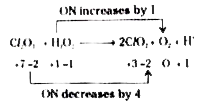Balance the following equations in basic medium by ion-electron method and oxidation number methods and identify the oxidising agent and the reducing agent.
(a) P4(s)+OH−(aq)→PH3(g)+HPO−2(aq)
(b) N2H4(I)+ClO−3(aq)→NO(g)+Cl−(g)
(c) Cl2O7(g)+H2O2(aq)→ClO−2(aq)+O2(g)+H+ Solution in Telugu
a) P4(s)+OH−(aq)→PH3(g)+H2PO−2(aq)
Ion electron method : P40+OH−−2,+1→PH3−3,+1+H2PO−2+1,+1,−2


Note : Here P4 acts both as oxidant and reductant.
Oxidation number method :
P4(s)(0)+OH−(aq)→PH3(g)(−3)+H2PO−2(aq)(+1)

In order to balance the change in oxidation number H2PO−2 is to be multiplied by 3
P4+OH−→PH3+3H2PO−2
Since the reaction is taking place in basic medium, H2O is to be added on the side which has ledder H atom and OH− are to be added on the side which has lesser O atoms.
P4+3H2O+3OH−→PH3+3H2PO−2
b) N2H4(l)+ClO−3(aq)→NO(g)+Cl−(g)

Step - III : Equalise the increase and decrease in ON by multiplying N2O4 with 3 and ClO−3 with 4.
3N2O4+4ClO−3→6NO+4Cl−
Step - IV : Balance the atoms except H and O. Here they are balanced.
Step - V : Balance O atoms by adding OH− ions and H atoms by adding H2O on the sides deficient of O and H atoms respectively
3N2O4+4ClO−3→6NO+4Cl−+12OH−
c) Cl2O7(g)+H2O2(aq)→ClO−2(aq)+O2(g)+H+
Ion electron method :

Oxidation number method :
Step - I : Skeleton equation is 
Step - II : Equalise the increases/decrease in ON by multipling H2O2 with 4 since in each chlorine of Cl2O7 decrease in ON is 4. For 2 Cl atoms it is 8. In H2O2 increase in ON for each 0 is 1 and for two 0 atoms it is 2.
Cl2O7+4H2O2→2ClO−2+4H2O+2O2
Step - III : Balance the O atoms by adding OH− and H atoms by adding H2O to the sides deficient of O and H atoms respectively.
Cl2O7+4H2O2+2OH−→2ClO−2+4H2O+2O2
Topper's Solved these Questions
- STOICHIOMETRYBOOK - VGS PUBLICATION-BRILLIANTCHAPTER - STOICHIOMETRYEXERCISE - LONG ANSWER QUESTION
13 Videos
- STOICHIOMETRYBOOK - VGS PUBLICATION-BRILLIANTCHAPTER - STOICHIOMETRYEXERCISE - ADDITIONAL QUESTIONS & ANSWERS
10 Videos
- STOICHIOMETRYBOOK - VGS PUBLICATION-BRILLIANTCHAPTER - STOICHIOMETRYEXERCISE - ADDITIONAL QUESTIONS & ANSWERS
10 Videos
- STATES OF MATTER : GASES AND LIQUIDSBOOK - VGS PUBLICATION-BRILLIANTCHAPTER - STATES OF MATTER : GASES AND LIQUIDSEXERCISE - ADDITIONAL QUESTION & ANSWERS
10 Videos
- THE P-BLOCK ELEMENTS - GROUP 13 BOOK - VGS PUBLICATION-BRILLIANTCHAPTER - THE P-BLOCK ELEMENTS - GROUP 13 EXERCISE - LONG ANSWER QUESTIONS
3 Videos
Similar Questions
Write the balanced ionic equation which represents the oxidation of iodine (I−) ion by per-manganate ion in basic medium to give iodine (I) and manganese dioxide (MnO2).
View SolutionCalculate molecular mass of glucose (C6H12O6) molecule.
View SolutionCalculate molecular mass of glucose (C6H12O6) molecule.
View SolutionA balloon is filled with hydrogen at room temperature. It will burst if pressure exceeds 0.2 bar, If at 1 bar pressure the gas occupies 2.27 L volume, upto what volume can the balloon be expanded?
View SolutionHow are borax and boric acid prepared ? Explain the action of heat on them.
View SolutionWrite balanced net ionic equations for the following reactions in basic solution: (a) H_(2)O_(2)(aq)+ClO_(4)^(Ө)(aq) rarr ClO_(2)^(Ө)(aq)+O_(2)(g) (b) ( c) Cu(OH)_(2)(s) + N_(2)H_(4)(aq) rarr Cu(s)+N_(2)(g) (d) MnO_(4)^(Ө) + IO_(3)^(Ө)(aq)rarr MnO_(2)(s) + IO_(4)^(Ө)(aq)
View SolutionBalance the following rebox reactions by ion electron method: a. MnO_(4)^(Θ)(aq)+I^(Θ)(aq) rarr MnO_(2)(s)+I_(2)(s) (in basic medium) b. MnO_(4)^(Θ)(aq)+SO_(2)(g) rarr Mn^(2+)(aq)+HSO_(4)^(Θ)(aq) (in acidic solution) c. H_(2)O_(2)(aq)+Fe^(2+)(aq) rarr Fe^(3+)(aq)+H_(2)O(l) (in acidic solution) d. Cr_(2)O_(7)^(2-)+SO_(2)(g) rarr Cr^(3+)(aq)+SO_(4)^(2-)(aq) (in acidic solution)
View SolutionBalance the following equations in basic medium by ion-electron method and oxidation number methods and identify the oxidising agent and the reducing agent. (a) P_(4)(s) + OH^(-) (aq) to PH_(3) (g) + HPO_(2)^(-)(aq) (b) N_(2)H_(4)(1) + ClO_(3)^(-) (aq) to NO(g) + Cl^(-)(g) (c) Cl_(2)O_(7)(g) + H_(2)O_(2)(aq) to ClO_(2)^(-)(aq) + O_(2) (g) + H^(+)
View Solutionनिम्नलिखित अभिकर्ताओं के समीकरणों को आयन इलेक्ट्रान तथा ऑक्सीकरण-संख्या विधि (क्षारीय माध्य में) द्वारा सन्तुलित कीजिए तथा इनमे ऑक्सीकरण और अपचायकों की पहचान कीजिए-
(क) P4(s)+OH−(aq)→PH3(g)+HPO−2(aq)
(ख) N2H(l)+CIO−3(aq)→NO(g)+CI−(g)
(ग) CI2O7(g)+H2O2(aq)→CIO−2(aq)+O2(g)+H+
View Solutionनिम्नलिखित अभिक्रियाओं के समीकरणों को आयन इलेक्ट्रॉन तथा ऑक्सीकरण संख्या विधि (क्षारीय माध्यम में) द्वारा संतुलित तथा इनमे ऑक्सीकरण और अपचायक की पहचान कीजिए -
(क) P4(s)+OH−(aq)→PH3(g)+H2PO2.−(aq)
(ख) N2H4(l)+ClO3.−(aq)→NO(g)+Cl−(g)
(ग) Cl2O7(g)+H2O(aq)→ClO2.−(aq)+O2(g)+H+
View SolutionBalance the following equation in basic medium by both oxidation number and ion electron method identify the reducatants and the oxidants (i) P_(4)NaOH+H_(2)O to PH_(3)+3NaH_(2)PO_(2) (ii) N_(2)H_(4)(g)+CIO_(3)^(-)(Aq) to NO(g)+CI^(-)(aq) (iii) CI_(2)O_(7)(g)+H_(2)O_(2)(aq) to CIO_(2)^(-)(aq)+O_(2)(g) (iv) Cr(OH)_(4)^(-)(aq)+H_(2)O(aq)to H_(2)O_(2)(aq) to CrO_(4)^(2-)(aq)+H_(2)O(l) (v) Zn(s)+NO_(3)^(-)(aq) to Zn^(2+)(aq)+NH_(4)^(+)(aq) (vi) AI(s)+NO_(3)^(-)(aq) to AI(OH)_(4)^(-)(aq)+NH_(3)(g) (vii) PbO_(2)(s)+CI^(-)(aq) to Pb(OH)_(3)^(-)(aq)+CIO^(-)(aq) viii) Fe(OH)_(3)(aq)+H_(2)O_(2)to Bi(s)+SnO_(3)^(2-)(aq) (ix) Bi(OH)_(3)(s)+SnO_(21)^(2-)(aq) to Bi(s)+SnO_(3)^(2-)(aq) (x) Cr (S)+CIO_(4)^(-)(aq) to Cr(OH)_(3)(s)+CIO_(3)(aq)
View SolutionBalance the following equations in basic medium by ion-electron method and oxidation number methods and identify the oxidising agent and the reducing agent.
(a) P4(s)+OH−(aq)→PH3(g)+HPO−2(aq)
(b) N2H4(1)+ClO−3(aq)→NO(g)+Cl−(g)
(c) Cl2O7(g)+H2O2(aq)→ClO−2(aq)+O2(g)+H+
View SolutionBalance the following equation in basic medium by both oxidation number and ion electron method identify the reducatants and the oxidants (i) P_(4)NaOH+H_(2)O to PH_(3)+3NaH_(2)PO_(2) (ii) N_(2)H_(4)(g)+CIO_(3)^(-)(Aq) to NO(g)+CI^(-)(aq) (iii) CI_(2)O_(7)(g)+H_(2)O_(2)(aq) to CIO_(2)^(-)(aq)+O_(2)(g) (iv) Cr(OH)_(4)^(-)(aq)+H_(2)O(aq)to H_(2)O_(2)(aq) to CrO_(4)^(2-)(aq)+H_(2)O(l) (v) Zn(s)+NO_(3)^(-)(aq) to Zn^(2+)(aq)+NH_(4)^(+)(aq) (vi) AI(s)+NO_(3)^(-)(aq) to AI(OH)_(4)^(-)(aq)+NH_(3)(g) (vii) PbO_(2)(s)+CI^(-)(aq) to Pb(OH)_(3)^(-)(aq)+CIO^(-)(aq) viii) Fe(OH)_(3)(aq)+H_(2)O_(2)to Bi(s)+SnO_(3)^(2-)(aq) (ix) Bi(OH)_(3)(s)+SnO_(21)^(2-)(aq) to Bi(s)+SnO_(3)^(2-)(aq) (x) Cr (S)+CIO_(4)^(-)(aq) to Cr(OH)_(3)(s)+CIO_(3)(aq)
View SolutionBalance the following equations in basic medium by ion-electron method and oxidation number methods and identify the oxidising agent and the reducing agent.
(a) P4(s)+OH−(aq)→PH3(g)+HPO−2(aq)
(b) N2H4(1)+ClO−3(aq)→NO(g)+Cl−(g)
(c) Cl2O7(g)+H2O2(aq)→ClO−2(aq)+O2(g)+H+
View SolutionBalance the following equation in basic medium by ion-electron method and oxidation number methods & Identify the oxidising agent of & the reducing agent. N_(2)H_(4)(l)+CIO_(3)^(-)(aq)toNO(g)+CI^(-)(g)
View Solution
